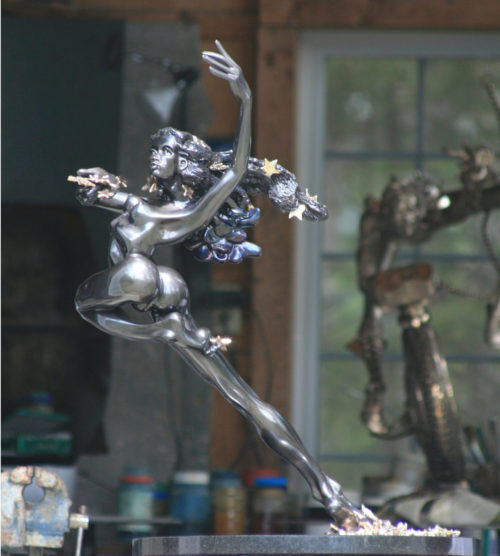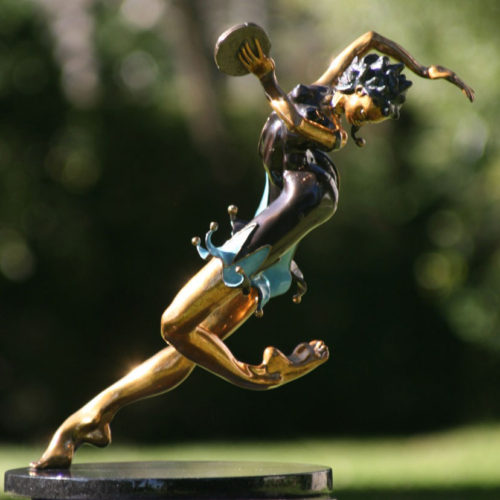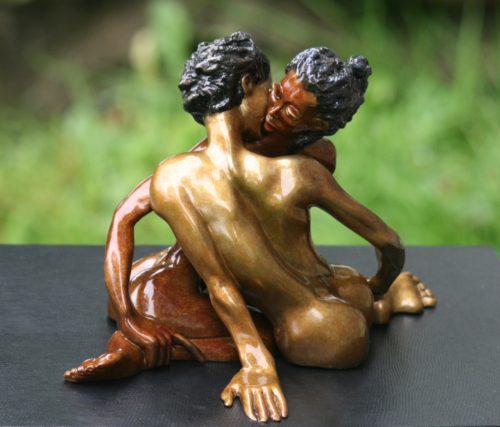CASSIOPEA 7 Feet OR 31 Inch
| Cassiopeia is an entity who has come from the deepest recesses of the universe to spread stars of happiness over the earth. Propelling forward like a meteorite with its scintillating plume, she resembles a shooting star. Her bluish hair, sprinkled with stars, is flowing behind her. Her right hand is filled with a myriad of stars that she is generously showering over the world with her breath. Her left hand is pointing to the stellar map from whence she originates. In the same manner that we place a shell to our ear to hear the sound of the ocean, she keeps a star to her ear, listening to the sound of the universe. Her right foot is bathed in a constellation of stars to highlight the sustainability of the source.
Schedar is the brightest star in the Cassiopeia constellation. Each life-sized sculpture in this series is named after one of the five stars of this constellation: Schedar, Caph, Tsi, Ruchbah (or Ksora) and Segin.Anecdote
As with everything, I taught myself how to enlarge my scale models. (At that period, I felt like the man who had decided to make a solo crossing of the Atlantic. If he didn’t accomplish this feat, part of him would die and the mirror would reflect only an incomplete image of him. When I built the frame for Schedar, I was leaving shore. God was I scared!) My system consisted of two wooden frames, one of seventeen inches for the tiny Cassiopea, the other seven feet tall for its large counterpart. At every joint was a multitude of nails and strings to be proportionally put into place. This intense construction site stood in the middle of the living room.
What problems did I encounter?
The first wax enlargement was not appropriate. I opted for clay, but the weight and instability of the material caused the central pivot and then the equivalent of several days’ work to fall to the ground. To strengthen the structure, I secured metal cables directly to the living room ceiling. The elasticity of the string changed the proportions. Once I reached the shoulders, the piece was beautiful and similar to the model but twenty-eight inches too high! The entire mass was starting to twist out of shape. Then, one evening as I was watching TV with my two sons, the sculpture turned on its axis. Covered in mud, the three of us managed to control the damage. (At that point I felt alone, in the middle of the ocean, without a compass. Should I give up?) Once again I strengthened the piece and decided to simply follow my instincts and improvise the enlargement. The cloths covering the piece had to be dampened every day. In these incredible surroundings, I even gave a conference to some fifty university students, ending with a “Rags 101” class! (Time went on. At the beginning, when all the disasters were occurring, I would tell God that this job was too hard and I was giving up. Two weeks later I would start over. During the final disasters, work never stopped for more than two days). When I reached the hands, I thought I was defeated. Although nearly perfect, the sculpture seems to be wearing ski gloves. (Would I ever see the shore again?) After many ups and downs, I was finally able to sit back and admire the piece, but only for a few days, because several steps still had to be carried out: the alginate, then plaster, and then the rubber mould, which resulted in my having to get a very short haircut, since I had gotten so much of it in my hair. Each subsequent step also brought its own inconveniences.Treatment: Bronze (7ft/3.3m) with black patina. The hair is bluish, and all the stars are mirror polished. On the artist’s proofs, the stars are plated with 24-carat gold.
A series of five, each bearing the name of one of the stars in the constellation: Schedar, Caph, Tsi, Ruchbah or Ksora, and Segin.
We sell Schedar at the Institute Ted Carrick at Cap Canaveral, Florida, USA
|
Project Details
-
Cassiopea
-
Nicole Taillon
-
H31 in
-
$19,500.r
-
Shipping Worldwide




